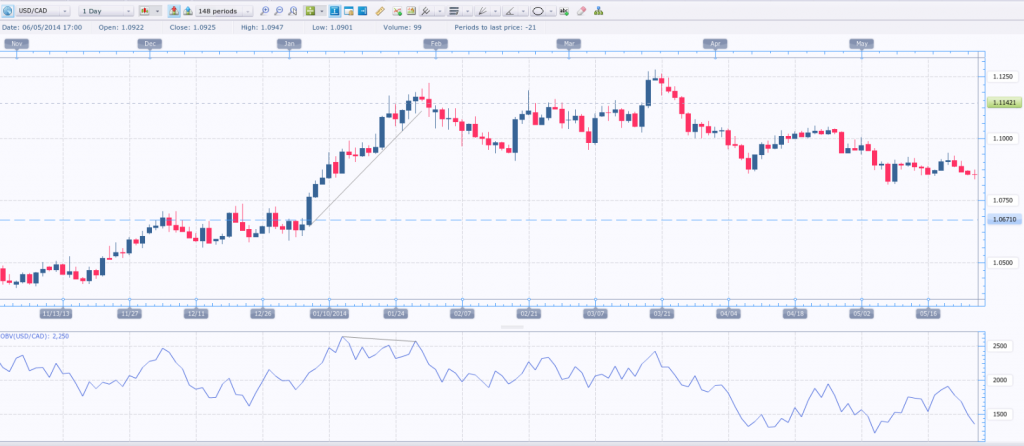On-Balance Volume – explanation and interpretation
You will learn about the following concepts
- What is the On-Balance Volume?
- How can it be interpreted?
What is the On-Balance Volume?
The On-Balance Volume (OBV) represents the running total of volume and as such it shows in what way volume can influence price momentum of a given asset. The OBV increases or decreases during each trading day in dependence on whether the price closes higher or lower compared to the close during the prior day. If a trading instrument closes higher, this implies that buyers overcame sellers. The volume of this instrument during that day is added to the OBV. If a trading instrument closes lower, this implies that sellers overcame buyers. The volume of the instrument during that day is subtracted from the OBV. If a trading instrument closes without change from the prior day, the OBV will also remain unchanged. It is considered as a leading indicator, as it increases or decreases before the price does.
How can it be interpreted?
A new peak in the OBV indicates that buyers are strong and sellers are weak, so the price of the trading instrument is likely to surge. A new bottom in the OBV indicates that sellers are strong and buyers are weak, so the price is likely to drop. If the OBV increases or decreases in consonance with the price, this means that the underlying trend is confirmed.
In case the price reaches a new peak and the OBV registers a new peak, the bull trend will probably continue. In case the price reaches a new bottom and the OBV makes a new bottom, the bear trend will probably continue. A trader would feel safer, if he/she makes entries in the direction of the trend, which is confirmed by the OBV.
When the OBV registers a new peak, this is indicative of buyers strength, while the price will probably surge to even higher levels. Therefore, this can be used as a signal to make a long entry in the market.
When the OBV drops to a new bottom, this is indicative of sellers strength, while the price will probably plunge even more. Therefore, this can be used as a signal to make a short entry in the market.
The most reliable buy and sell signals are provided when the OBV diverges from the price. In case the price surges, then falls, after which rises again to a higher high, but the OBV marks a lower high, this produces a bearish divergence, thus, a reliable signal to go short. In case the price drops, then rallies, after which falls again to a lower low, but the OBV marks a higher low, this produces a bullish divergence, a reliable signal to go long. Longer-term divergences are more reliable than shorter-term divergences. Divergences, which form during several weeks, provide more reliable signals than those, which form during several days. On the daily chart of USD/CAD below we can see a typical bearish divergence between prices and the OBV.
When the market is in a trading range and the OBV surges to a new high, this can be considered as a signal to go long. When the market is in a trading range and the OBV falls to a new low, this can be considered as a signal to go short.
